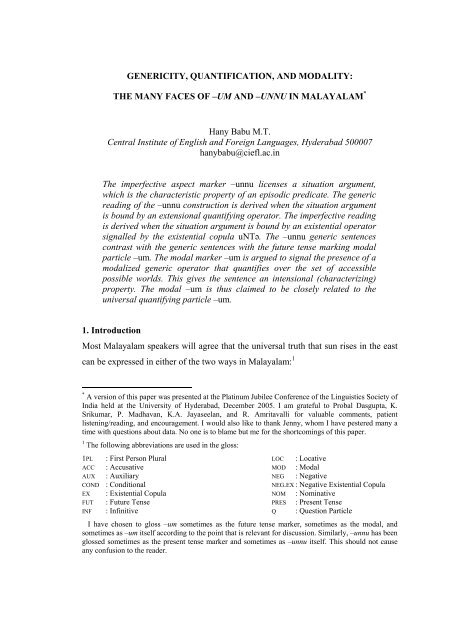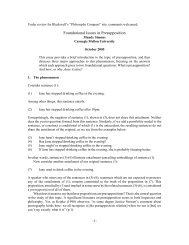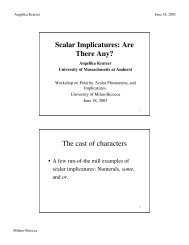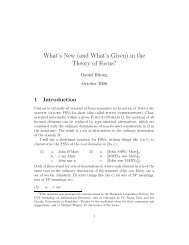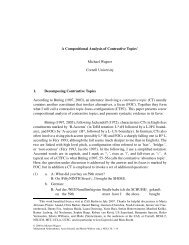TWO TYPES OF GENERICITY IN MALAYALAM
TWO TYPES OF GENERICITY IN MALAYALAM
TWO TYPES OF GENERICITY IN MALAYALAM
- No tags were found...
You also want an ePaper? Increase the reach of your titles
YUMPU automatically turns print PDFs into web optimized ePapers that Google loves.
<strong>GENERICITY</strong>, QUANTIFICATION, AND MODALITY:THE MANY FACES <strong>OF</strong> –UM AND –UNNU <strong>IN</strong> <strong>MALAYALAM</strong> *Hany Babu M.T.Central Institute of English and Foreign Languages, Hyderabad 500007hanybabu@ciefl.ac.inThe imperfective aspect marker –unnu licenses a situation argument,which is the characteristic property of an episodic predicate. The genericreading of the –unnu construction is derived when the situation argumentis bound by an extensional quantifying operator. The imperfective readingis derived when the situation argument is bound by an existential operatorsignalled by the existential copula uNTə. The –unnu generic sentencescontrast with the generic sentences with the future tense marking modalparticle –um. The modal marker –um is argued to signal the presence of amodalized generic operator that quantifies over the set of accessiblepossible worlds. This gives the sentence an intensional (characterizing)property. The modal –um is thus claimed to be closely related to theuniversal quantifying particle –um.1. IntroductionMost Malayalam speakers will agree that the universal truth that sun rises in the eastcan be expressed in either of the two ways in Malayalam: 1* A version of this paper was presented at the Platinum Jubilee Conference of the Linguistics Society ofIndia held at the University of Hyderabad, December 2005. I am grateful to Probal Dasgupta, K.Srikumar, P. Madhavan, K.A. Jayaseelan, and R. Amritavalli for valuable comments, patientlistening/reading, and encouragement. I would also like to thank Jenny, whom I have pestered many atime with questions about data. No one is to blame but me for the shortcomings of this paper.1 The following abbreviations are used in the gloss:1PL : First Person Plural LOC : LocativeACC : Accusative MOD : ModalAUX : Auxiliary NEG : NegativeCOND : ConditionalNEG.EX : Negative Existential CopulaEX : Existential Copula NOM : NominativeFUT : Future Tense PRES : Present Tense<strong>IN</strong>F : Infinitive Q : Question ParticleI have chosen to gloss –um sometimes as the future tense marker, sometimes as the modal, andsometimes as –um itself according to the point that is relevant for discussion. Similarly, –unnu has beenglossed sometimes as the present tense marker and sometimes as –unnu itself. This should not causeany confusion to the reader.
<strong>GENERICITY</strong>, QUANTIFICATION, AND MODALITY 42.1 Characterizing sentences and accidental generalizationsCharacterizing sentences are said to have the following properties:1. In characterizing sentences the property described by the verbal predicate isan “essential” property of some entity mentioned in the sentence.2. The subject or other NP of a characterizing sentence may be any type ofNP.3. Characterizing predicates may be habitual (i.e., derived from an episodicpredicate) as in (2)b above, or lexical (i.e. a stative predicate) as in (2)cabove.It is the first point that is of essential importance to us. An essential property has“law-like” (normative or nomic) quality. An essential property contrasts with anaccidental generalization, which holds true because of a “quirk of fate.”Greenberg (2003) offers the following scenario to explain this difference.Imagine that there are only eight lions left in the world and seven of them lost a legdue to some reason. (3)a will be true as an accidental property of lions. However, (3)band (3)c will still not be true as they talk about characteristic properties of lions.(3) a. Most lions have three legs.b. A lion has three legs.c. Lions have three legs.Another property of characterizing sentences is that they support counterfactualstatements. Dahl (1975) says that the following argument will be valid only if the firstsentence is understood as a characterizing (nomic) property:(4) My friends vote for the Socialists. Hence, if you had been my friend, youwould have voted for the Socialists.If the property of voting for Socialists were an accidental property, the argumentwould not hold.Both these properties of characterizing sentences can be explained if they areviewed as “intensional” in that they make a generalization of the state of affairs in allthe accessible possible worlds. So a situation contrary to the one described by acharacterizing sentence is not plausible at all. However, the usual problem in thesemantics of the generic operator Gen holds true in the characterizing sentences aswell. That is to say, it has been noted that generic sentences allow for exceptions,
<strong>GENERICITY</strong>, QUANTIFICATION, AND MODALITY 8(9) a. *pancasaara weLLatt-il aliy-unnusugar water-LOC dissolve-UNNUb. pancasaara weLLatt-il aliy-umsugar water-LOC dissolve-UM‘Sugar dissolves in water.’The property of being soluble in water is an essential property of sugar. Thisgeneralization is not dependent on any particular episode of sugar having beendissolved in water.3.4 Supporting counterfactualsIn § 2.1 above, we said that only characterizing predicates support counterfactuals. Ishow that only generalizations made by –um support counterfactuals. A generalizationof the same fact made by –unnu does not support the counterfactual. (10)a where wehave –um can be felicitously followed by the counterfactual statement, but not (10)bin which we have –unnu.(10) a. dakSina indiakkaar dhaaraaLam ari-bhakSaNam kazhikk-um.south Indians plenty rice-food eat-UMawan dakSina indiakkaaran aayirunn-enkil, awanhe south Indian was-if heari-bhakSaNamrice-foodkazhikk-um-aayirunnueat-UM-AUXILIARY‘South Indians eat plenty of rice. If he were a South Indian, then hewould have eaten rice.’b. dakSina indiakkaar dhaaraaLam ari-bhakSaNam kazhikk-unnu.south Indians plenty rice-food eat-UNNU#awan dakSSina indiakkaaran aayirunn-enkil, awanhe south Indian was-if heari-bhakSaNamrice-foodkazhikk-um-aayirunnueat-UM-AUXILIARY‘South Indians eat plenty of rice. #If he were a South Indian, then hewould have eaten rice’
<strong>GENERICITY</strong>, QUANTIFICATION, AND MODALITY 14All the polarity sensitive items and the universal quantifier are related in fairlyobvious ways. This is evident from the vast amount of literature on it and from thefact that many languages including English use the same morpheme to encode manyof these meanings, as the English any for instance. 6In the last section, I argued that generic sentences with –um have a modalizeduniversal operator as they give rise to characterizing property. The parallel is now tooobvious to miss. When attached to an NP, -um gives the NP a quantificationalreading; when attached to a verb, -um gives it a quantificational reading which is alsointensional. Modality is best understood in terms of possible worlds. Intensionalityhas also been characterized in terms of possible worlds. My claim, then, is that –umlicenses a quantificational operator. When it occurs in the modal domain, it quantifiesover the set of accessible possible worlds. When it occurs in the NP domain, itquantifies over individuals.What about the meaning of –um as a future marker? I will argue that –um hasthe intensional quantification force even when it is used to convey simple futurity.Consider a sentence like:(17) naaLe mazha peyy-umtomorrow rain pour-UM‘It will rain tomorrow.’The meaning conveyed by (17) above is something like: “All accessible possibleworlds that are located in tomorrow are worlds in which there is rain.” That is to say,there seems to be a hidden universal quantificational force in sentences conveyingsimple future meaning with –um. In fact, this quantificational force should beresponsible for the certainty that is associated with the modal suffix –um as opposedto other modal suffixes like –aam.(18) naaLe mazha peyy-aamtomorrow rain pour-MOD‘It may rain tomorrow.’6 It is not possible to survey the extensive literature on these topics. For a discussion of the semantics ofuniversal quantifiers and polarity sensitive and free choice items see Dayal 2005, Giannakidou 1998,and Giannakidou and Cheng 2005, among others.
<strong>GENERICITY</strong>, QUANTIFICATION, AND MODALITY 15The quantification, again, seems to be quantification over possible worlds. Thedifference between simple future and the characterizing predicate, then, will be interms of restricting the time span. If the time span is restricted to a particular time, weget simple futurity. Unbounded time span gives you a characterizing predicate. Recallthat it is the unbounded time span which gives rise to genericity in the case of –unnusentences as well as discussed in § 3.8 above. 74.2 A unifying approach to the imperfective and the generic -unnuHM have argued that there are two -unnus in Malayalam: an -unnu that is theimperfective aspect morpheme, and an -unnu that occurs in generic constructions. Theargument that is put forth is that the -unnu that is marked for the imperfective aspectcan be followed by uNTə (the existential copula) and negated by illa (the negativeexistential copula), while the –unnu in generic construction can do neither. 8(19) a. bassə var-unnubus come-UNNU‘The bus is coming.’b. bassə var-unn uNTəbus come-UNNU EX‘The bus is coming.’c. bassə var-unn illabus come-UNNU NEG.EX‘The bus is not coming.’7 Probal Dasgupta (pc) raises an interesting question: why does a language like Malayalam choose thesame form as a quantificational element and a modal, as opposed to a language like English which doesnot use all as a modal or will as a quantifier. At this point, I have no answer to offer to this question,other than note that languages, as the famous saying goes, seem to differ in terms of how muchsemantics they were on their sleeves. The fact that universal quantification, which is logicallyconsidered to be infinite conjunction, is expressed by the conjunctive particle in Malayalam is alreadyan indication of the transparency of semantics in Malayalam morphology. To complete the story, itmay be interesting to note that existential quantification, which is logically considered to be infinitedisjunction, is expressed by the disjunctive particle –oo in Malayalam as in aar-oo ‘someone.’ SeeMadhavan 1997 for a discussion.8 The inability to negate using illa seems to be more a property of contemporary Malayalam. OlderMalayalam seems to have allowed this as seen in the biblical sentence:kaakkakaL-e nookkuvin awa witaykk-unn-illa koyy-unn-illaravens-ACC look they sow-UNNU-not reap-UNNU-not‘Consider the ravens: they don’t sow, they don’t reap.’ (Luke 12:24)Note that the generalization made here is purely descriptive as we predict, and not nomic.
<strong>GENERICITY</strong>, QUANTIFICATION, AND MODALITY 16(20) a. suuryan kizhakkə udikk-unnusun east rise-UNNU‘The sun rises in the east.’b. *suuryan kizhakkə udikk-unn uNTəsun east rise-UNNU EXIntended reading: ‘The sun rises in the east.’ (Ok as: ‘The sun is rising inthe east.’)c. *suuryan paTiññaarə udikk-unn illasun west rise-UNNU NEG.EXIntended reading: ‘The sun does not rise in the west.’The interpretation of the (19) and (20) clearly shows the contrast between theprogressive and the simple present tense reading. When the –unnu that can befollowed by -uNTə gets the progressive interpretation, while the other one gets thesimple present reading. (Note that this reading is obtained even when the auxiliaryuNTə is not overt as in (19)a.) Our current task is to account for these two readings of–unnu. Are they two different uses of –unnu, or can we think of a common analysisfor these two meanings? In fact, Amritavalli and Jayaseelan (2002) (henceforth AJ)have argued that –unnu is the imperfective morpheme. According to their analysis,there is no tense (either as a morphological or as a syntactic category) in Malayalamand Kannada. I shall turn to the question of tense in Malayalam in § 5 below. In thenext section I shall offer an analysis that unifies the semantics of –unnu in theimperfective and the generic construction.4.3 A uniform semantics for constructions involving -unnuIn our analysis in § 3 above, we said that –unnu derives its generic reading by thecollusion of two factors: (i) the presence of a situation argument (ii) by the presenceof a quantificational operator (which is extensional). In fact, predicates which have asituation argument are prototypically episodic in nature. 9 As argued by Krifka et al(1995), the predicate gets an episodic interpretation when the situation argument isbound by existential closure. In (19)b above, we found that a sentence like bassəvarunn-uNTə ‘the bus is coming’ can only get an episodic reading. This should mean9 See the discussion in § 2 above and references therein.
<strong>GENERICITY</strong>, QUANTIFICATION, AND MODALITY 17that the situation argument is getting bound an existential operator in this case. If weconsider the fact that uNTə is the existential copula in Malayalam, we have anexplanation for the episodic reading of (19)b. In Hany Babu 2006, I have argued thatthe existential copula is associated with an existential operator. So what we can say isthat in the imperfective construction, the existential operator binds the situationargument and gives rise to episodic reading. Thus we have a common analysis forconstructions involving –unnu. Morphologically –unnu might be an imperfectivemorpheme. But its semantics in contemporary Malayalam is that it gives rise to anepisodic predicate with a situation argument. If it is bound by a generic operator, itgives rise to a generic sentence. If it is bound by the existential operator, it gives riseto an episodic sentence. However, we should bear in mind that the generic operatorthat occurs with –unnu is purely extensional in nature and is different from theintensional operator GEN. 10Since we get the imperfective interpretation even when uNTə is not overt (as in(19)a bassə varunnu ‘the bus is coming’), we can posit a null morphemecorresponding to uNTə in the imperfective constructions.Thus, we see that our analysis is able to reduce the two different uses of –unnuto the difference in the operator. We have a unified analysis of –unnu in the sense thatit licences a situation argument for the predicate. We have also been able to provide aunified semantic analysis for the occurrence of –um in future tense and in genericsentences. However, I do not refute the existence of tense as a grammatical categoryin Malayalam. I turn to this in the next section.5. Tense in MalayalamAJ claim that there is no Tense (or TP) in Malayalam and Kannada. They argue thatall the putative tense markers are aspect markers. It is indeed true that the borderlinebetween tense and aspect marker is not finely defined in Malayalam, or, for thatmatter, in most languages. However, as argued by HM, denying the existence ofTense as a syntactic category cannot be settled just by taking into consideration the10 In fact, one can go further and say that the difference between the two kinds of genericity lies not inthe operator, but in the kind of variable that the operator binds. In the modal context, the operator bindsa variable that ranges over the set of accessible possible worlds, and in the nonmodal context, it binds avariable that ranges over episodes that are extensionally located. This possibility can only be exploredif we go into a formal analysis. I leave this aside for future work.
<strong>GENERICITY</strong>, QUANTIFICATION, AND MODALITY 18morphological manifestation of tense and aspect. In this paper, I will reiterate theview of HM by summarizing and adding to their arguments.If we take the view that aspect concerns with the internal temporal constituencyof the event, while tense concerns with external factors like event time and speechtime as argued by Comrie 1976 and 1985 and a host of other authors, it would notmake any sense to argue that there is no tense in a sentence like (21) below, sincethere is after all a deictic time reference, which is taken to be the hallmark property oftense.(21) awan wannuhe came‘He came.’Another point that I would like to make is based on the history ofgrammaticalization processes in languages. It is well attested that tense markers haveevolved from aspect markers. Dahl 1995, quoting work by Bybee and Dahl (1989),states that the most frequent paths of grammaticalization as:a. Perfects develop into pasts or perfectivesb. Futures develop out of so-called prospective or constructionsexpressing intention, volition, or obligationc. (Present) progressives develop into presents or imperfectivesMalayalam seems to follow this well-beaten track. Modifying the analysis of AJ, wecan say that the past tense form has evolved out of the perfective. If the analysis inHany Babu 1996 is on the correct track, the future has evolved out of a modal marker.The progressive –unnu, then, can be claimed to have developed into the present andthe imperfective. As we have seen, it is this form that is used in the genericconstructions as well. 1111 Dahl (1995) also cites the case of Hindi where bolta hai (‘(he) speaks’), which was once used inprogressive constructions, has come to be used in present tense. Another form bol raha hai is now usedin the progressive.One can also speculate the perfect forms like the one with iTTuNTə (as in vann-iTTuNTə ‘hascome’) may have developed at a later stage in the development of Malayalam.
<strong>GENERICITY</strong>, QUANTIFICATION, AND MODALITY 195.1 Tense without finiteness, finiteness without tense: Two problems for AJAJ are troubled by two factors: (i) Certain finite clauses in Kannada (and inMalayalam) have no tense morphology, but show finiteness – that is to say, there arefinite clauses that have no tense morphology. (ii) The tensed form of the verb occursin certain non-finite constructions like the gerund – that is to say, there are non-finiteconstructions with tense morphology. 12 The following data exemplify these twoinstances: 13 (22) is finite, but there is no tense morpheme, while (23), which is nonfinitehas a tense morpheme.(22) avanu bar-al(u) illahe come-<strong>IN</strong>F NEG‘He did not come.’(23) [avan var-unn-at]-ine patti ñaŋŋaL samsaari-ccuhe come-NONPAST-NOM-ACC about we talked-PAST‘We talked about his coming.’The best one can say from the facts from Dravidian is that they actually supportthe widely held notion that tense and finiteness are indeed two different animals.George and Kornfilt (1981) have argued for the existence of tense in Turkish nominalclauses. Thus (24)a has a finite embedded clause and (24)b a non-finite embedded(nominal) clause. But both of them are marked for past tense. In fact, it is the absenceof agreement morpheme that will distinguish the non-finite construction from thefinite.(24) a. Ahmet [biz viski-yi iç-ti-k] san-ÆyorAhmet we whiskey-ACC drink-PAST-1PL believe-PRES‘Ahmet believes (that) we drank the whiskey.’b. Ahmet [biz-i viski-yi iç-ti] san-ÆyorAhmet we-ACC whiskey-ACC drink-PAST believe-PRES‘Ahmet believes us to have drunk the whiskey.’12 AJ say that analyzing –unnu as tense marker leads to the “embarrassment of tense inside gerunds.”HM counter this by saying that “no tense within non-finite clauses” need not be taken as a “gospeltruth.”13 (22) and (23) are adapted from AJ. (22) is Kannada and = AJ’s 3b and (23) is Malayalam and = AJ’s34a.
<strong>GENERICITY</strong>, QUANTIFICATION, AND MODALITY 20In fact, it has been traditionally established that it is agreement that marksfiniteness in Dravidian languages like Tamil, Kannada, and Telugu. Thus a finite andnon-finite construction contrasts by virtue of the presence or absence of agreement.band-aru ‘came’ in (25)a is finite and it has agreement morphology. band-udu in(25)b is the nominal form and is non-finite, but is marked for past: 14(25) a. awaru band-aruthey came-AGR‘They came.’b. [awaru band-udu] namag-ella: santo:Sathey came-NOM we.DAT-ALL happy‘We are all happy that they came.’Thus we see that it is the presence or absence of agreement morphology and nottense that is crucial for determining finiteness in Dravidian just as in Turkish.However, the question whether Dravidian has a TP needs to be considered moreseriously. To the best of my knowledge, there is no empirical argument provided byany author for the existence or non-existence of functional categories like TP inDravidian. Most authors have just assumed their existence. However, Mathew (2005)argues that there is no evidence for a TP in Malayalam. This might be a plausibleanalysis of the Dravidian clause structure. However, I leave this aside for furtherresearch.5.2 –unnu and deictic time referenceIn this section, I will show that the imperfective –unnu does indeed have deictic timereference in certain non-finite constructions. Consider the following contrast noted byMadhavan (2001): 15(26) a. jooN ezhut-i-yat∂ kavita aaN∂/aayirunnuJohn write-PAST-NOM‘It is a poem that John wrote.’poem be.PRES/PAST14 (25) is adapted from Tirumalesh 2000 with some modifications. The question whether band encodestense or aspect is not crucial here. The point is that band + AGR is finite, without AGR band is nonfinite.15 (26)a and b are adapted from Madhavan 2001. (26)a = Madhavan’s 15 and b = 16. Madhavanprovides the same translation for a and b. I, however, feel that there is a slight difference in themeaning.
<strong>GENERICITY</strong>, QUANTIFICATION, AND MODALITY 21b. jooN ezut-unn-at∂ kavita aaN∂ / *aayirunnuJohn write-UNN-NOM poem BE.PRES / *BE.PAST‘What John is writing is a poem / *was a poem.’The point Madhavan makes is that while the present tense aaNə and the past tenseaayirunnu are compatible with the past (or perfective) ezuti as in (26)a, only thepresent tense (realized as aaNə) can occur with the progressive ezutunn- in (26)b.Madhavan attributes this to the incompatibility of past tense with the progressive. Thequestion that is left unaddressed in Madhavan’s analysis is why there should be such arestriction between cooccurrence of the past tense and the progressive aspect.In fact, it would be strange if there is a restriction on progressive aspect andpast tense occurring together in a sentence. It makes more sense to say that the pasttense aayirunnu cannot occur (26)b because of a clash in tense – the past tense and thepresent tense. That is to say, aayirunnu on the matrix clause situates the time of theevent in the past. 16 And the event described by the verb in the cleft clause cannotrelate to the present (speech) time. The contrast in pairs like the following beartestimony to this clash of tenses:(27) a. It was a poem that John was writing.b. *It was a poem that John is writing.The Malayalam examples in (26) above show nothing other than this kind of contrast.This can be taken to be a clinching piece of evidence to show that the cleft clause isindeed marked for tense and not for aspect. However, I maintain the claim that thecleft clause is non-finite. That is to say, it has tense, but is not finite.6. ConclusionIn this paper, I have shown that different types of genericity arise in Malayalam due tothe collusion between the semantic properties of the generic operators and thevariables they bind. A characterizing sentence has a modalized universal operator.The Malayalam modal marker –um signals the presence of such an operator. Themodal operator binds a variable that ranges over the set of accessible possible worlds.If the time span of the possible world is unbounded, we get a characterizing predicate.16 Madhavan (2001) analyzes the cleft sentences as monoclausal (contra Madhavan 1987). If the cleftclause has tense as I claim this analysis becomes circumspect. However, I do not intend to go into thoseaspects in this paper.
<strong>GENERICITY</strong>, QUANTIFICATION, AND MODALITY 22If the time span is restricted to some particular time, we get a sentence with a simplefuture meaning. I have argued that there is a close link between the –um that occurs inthe generic sentences and the –um that occurs in universal quantifiers and polaritysensitive items.The other kind of generic sentence is the one that makes a generalization over aseries of episodes. This is made possible when a generic operator binds a situationargument introduced by the imperfective –unnu. When the situation argument isbound by an existential operator, we get an episodic (imperfective) reading.Both types of genericity, thus, involve quantification: in one the operatorquantifies over a variable that ranges over a set of accessible possible worlds, in theother, the operator quantifies over situations in time. This paper can only beconsidered as a preliminary enquiry into the complexities of the semantic andsyntactic properties of these constructions. A much thorough and rigorousinvestigation is needed in order to unravel the deeper properties behind theseconstructions.ReferencesAmritavalli, R. and K.A. Jayaseelan. 2002. Finiteness and negation in Dravidian.CIEFL Occasional Papers in Linguistics 10. (Later published in Guglielmo Cinqueand Richard Kayne eds. 2005. The Oxford handbook of comparative syntax. NewYork: Oxford University Press.)Asher R.E. and T.C. Kumari. 1997. Malayalam. London: Routledge.Carlier, Anne. 1989. Généricité du syntagme nominal sujet et modalités. Travaux deLinguistique 19:33-56.Carlson, Gregory N. 1980. Reference to kinds in English. New York: Garland.Carlson, Gregory N. 1995. Truth conditions of generic sentences: Two contrastingviews. In Carlson and Pelletier eds.Carlson, Gregory N. and Francis J. Pelletier eds. 1995. The generic book. Chicago:Chicago University Press.Comrie, Bernard. 1976. Aspect: An introduction to the study of verbal aspect andrelated problems. Cambridge: Cambridge University Press.
<strong>GENERICITY</strong>, QUANTIFICATION, AND MODALITY 23Comrie, Bernard. 1985. Tense. Cambridge: Cambridge University Press.Dahl, Östen. 1975. On generics. In Ed Keenan ed. Formal semantics of naturallanguage. Cambridge: Cambridge University Press.Dahl, Östen. 1995. The episodic/generic distinction in tense-aspect systems. InCarlson and Pelletier eds.Dayal, Veneeta. 2005. The universal force of free choice any. In Pierre Pica ed., Thelinguistic variation yearbook 4. Amsterdam: John Benjamins.George, Leland and Jaklin Kornfilt. 1981. Finiteness and boundedness in Turkish. InFrank Heny ed. Binding and filtering. London: Croom Helm.Giannakidou, Anastasia. 1998. Polarity sensitivity as (non)veridical dependency.Amsterdam: John Benjamins.Giannakidou, Anastasia and Lisa Cheng. 2005. (In)Definiteness, polarity, and the roleof wh-morphology in free choice. To appear in Journal of Semantics.Greenberg, Yael. 2003. Manifestations of genericity. New York: Routledge.Hany Babu, M.T. 1996. The binarity of Malayalam tense system: Some preliminaryremarks. PILC Journal of Dravidic Studies. 6:1-10.Hany Babu, M.T. 2006. The two copulas of Malayalam revisited. Proceedings of theFirst National Symposium on Modeling and Shallow Parsing of Indian LanguagesApril 2-4, 2006, Department of Computer Science and Engineering, Indian Institute ofTechnology, Bombay.Hany Babu, M.T. and P. Madhavan 2002. The two lives of –unnu: A response toAmritavalli and Jayaseelan. CIEFL Occasional Papers in Linguistics 10.Jayamohan. 2001. NeTumpaatayooram. Thrissur: Current Books.Jayaseelan, K.A. 2001. Questions and question-word-incorporating quantifiers inMalayalam. Syntax 4:263-293.John, Athialy P. 1987. The semantics of modality: A study based on Malayalam andEnglish. Thiruvananthapuram: Dravidian Linguistics Association.König, Ekkehard. 1991. The meaning of focus particles: A comparative perspective.London: Routledge.
<strong>GENERICITY</strong>, QUANTIFICATION, AND MODALITY 24Krifka, Manfred, Francis Jeffry Pelletier, Gregory N. Carlson, Alice ter Meulen,Gennaro Chierchia, and Godehard Link. 1995. Genericity: An introduction. InGregory N. Carlson and Jeffry Pelletier eds.Madhavan, P. 1987. Clefts and pseudoclefts in English and Malayalam. Doctoraldissertation, CIEFL, Hyderabad.Madhavan, P. 1997. How do languages make up their quantifier phrases: Acrosslinguistic investigation. In Hariprasad et al eds. Phases and interfaces ofmorphology, Hyderabad: CIEFL.Madhavan, P. 2001. The cleft question and the question of clefts. Manuscript, CIEFL,Hyderabad.Mathew, Rosmin. 2005. SIMPLy Malayalam participials. Paper presented atCONSOLE XIV, December 2005, University of the Basque Country, Spain.Rajarajavarma, A.R. 1917. Keralapaniniiyam: A treatise on Malayalam grammar.Translated by C.J. Roy. (1999). Trivandrum: International School of DravidianLinguistics.Rajasekharan Nair. 2002. Temporal notions in Malayalam and Tamil. Talk at theArchitecture of Grammar held at CIEFL, Hyderabad.Tirumalesh, K.V. 2000. The landscape of language: issues in Kannada linguistics.New Delhi: Allied.


